Oil
- Crude oil remains at high levels at the start of the new week, which is also the final week of this quarter. However, the price is slightly below the local peaks from last week
- Crude oil inventories in the US have not changed significantly in recent weeks, but seasonality suggests a decline in stockpiles in the coming weeks. If the decline does not occur, it will indicate that demand is not so strong
- The Crack Spread has remained low since the beginning of this month, which does not suggest increased demand for petroleum products. Considering the 30-40 day lead time of the crack spread, we could theoretically expect a continuation of the declines
- The spread of the nearest WTI and Brent oil contracts is slightly retracting, which may suggest the formation of a local peak
- U.S. oil production reaches 13.2 million barrels per day, despite the still decreasing number of drilling rigs
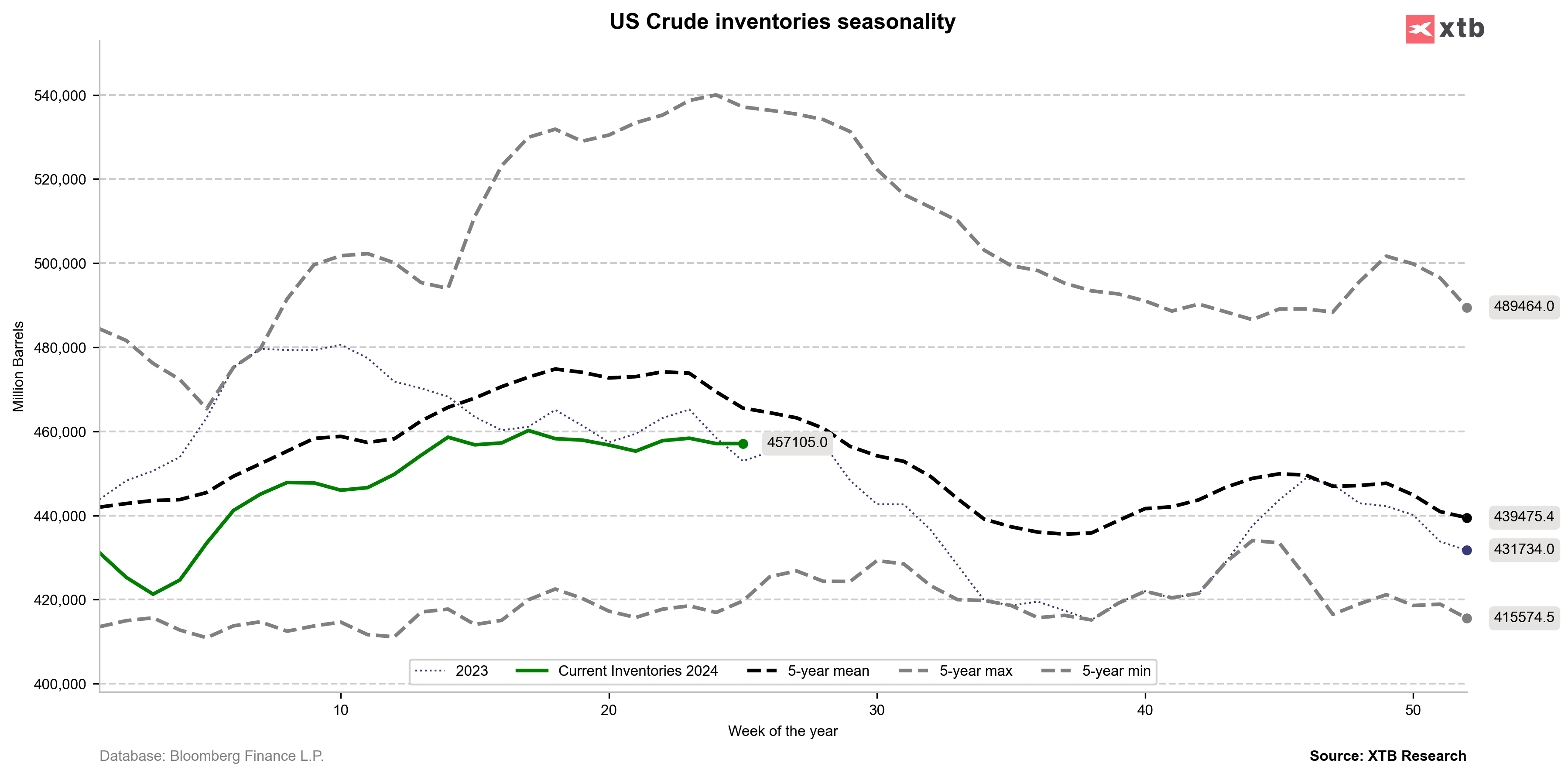
Crude oil inventories have not changed significantly in recent weeks, which also does not provide a directional signal for oil prices. If inventories start to decline in-line with seasonality, oil prices could be maintained at a high levels. It is crucial for prices to keep inventories below the 5-year moving average or last year's levels. Source: Bloomberg Finance LP, XTB
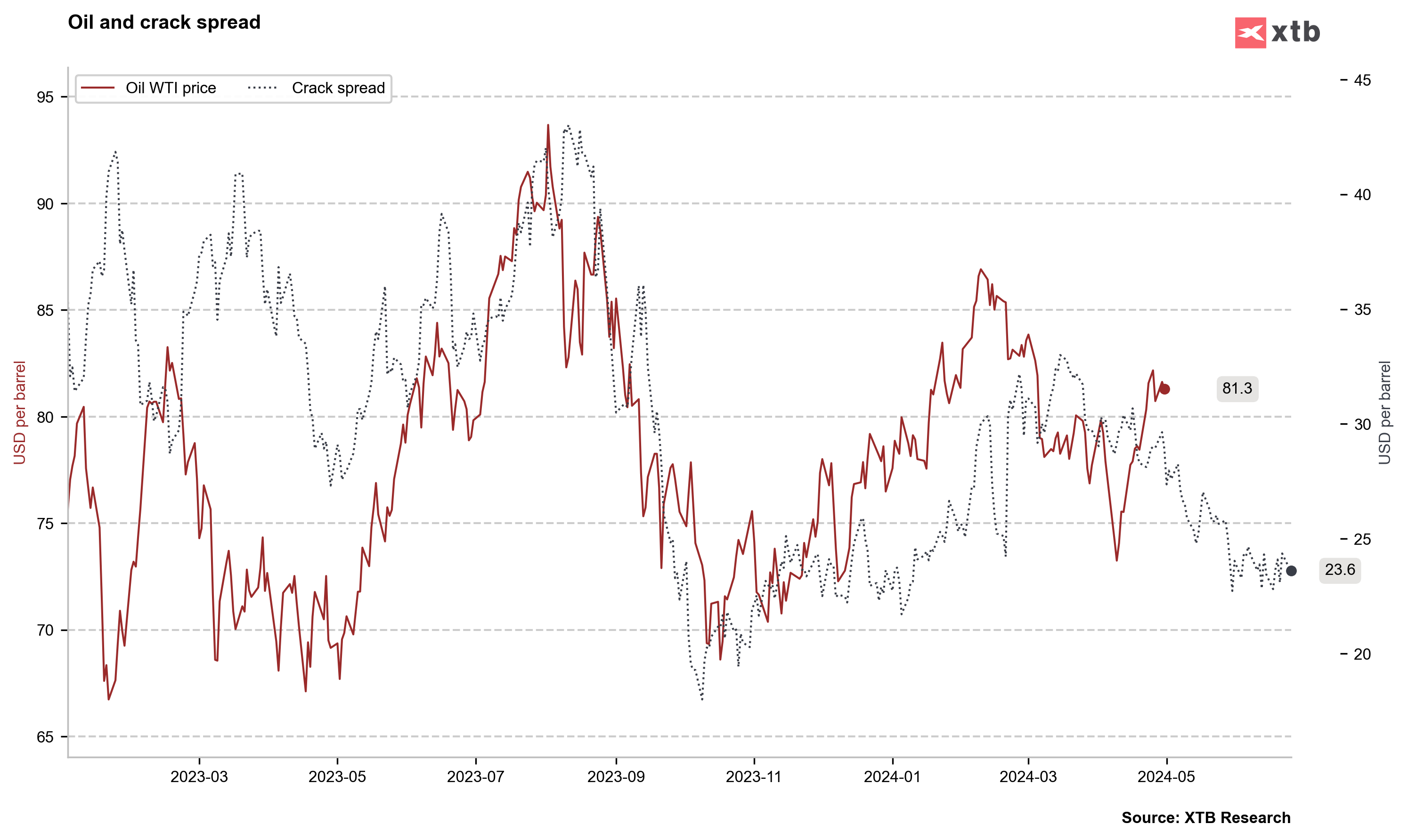
The crack spread suggests that we are not seeing excessive demand at the moment. However, since early June, we have not seen a further decline in the crack spread. Source: Bloomberg Finance LP, XTB
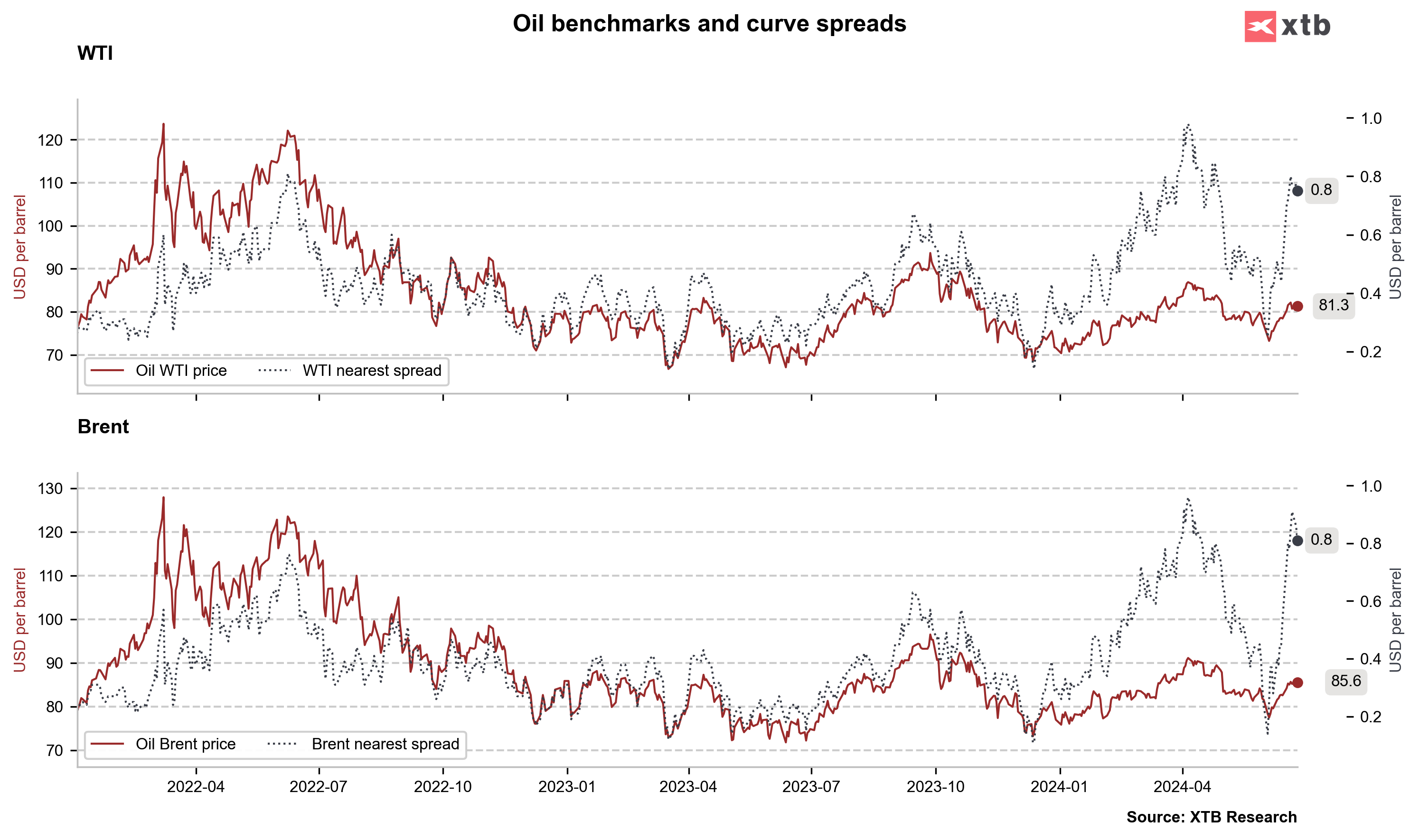
The spreads of the nearest futures contracts on oil have seen slight declines after the recent strong breakout, which suggested an increase in short-term demand for oil. However, if the declines continue, it could put pressure on a corrective drop following the recent rebound. Source: Bloomberg Finance LP, XTB
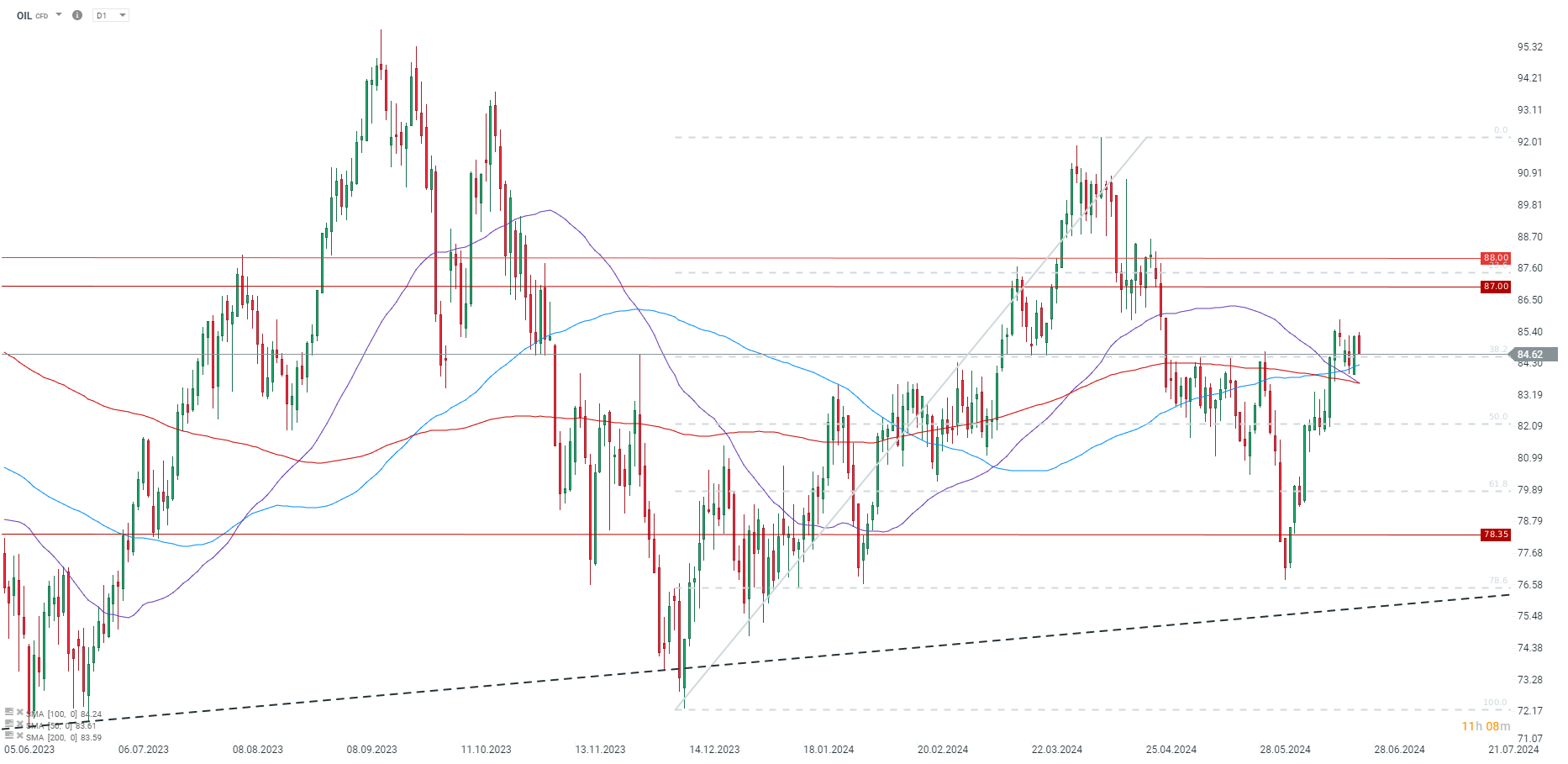
Brent oil is above the 50, 100, and 200-period moving averages. However, after the V-shaped rebound, an attempt at correction cannot be ruled out if oil inventories do not start to decline soon or if there is no rebound in the crack spread, which is an indicator of potential demand. Source: xStation5
Natural Gas
- Weather forecasts in the US show that colder air masses are approaching from the northwest. However, significantly above-average temperatures are expected to persist in the southeast
- Gas production has recently rebounded noticeably, which may also be related to slightly higher gas prices in recent times. Gas production significantly increased during the summer last year
- Seasonality indicates that a local bottom may be very close. On the other hand, if temperatures drop, the correction might continue. Seasonality in gas is tied to the peak usage of gas for electricity production at the turn of July and August. Simultaneously, it is also linked to the structure of the futures curve itself, which assumes higher prices in the coming months due to rebounding demand
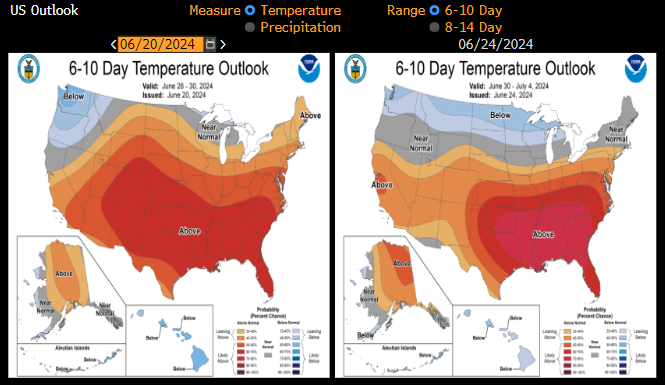
Temperatures in the US are expected to be slightly lower in the northwest, which may affect the return of demand to around the 5-year average. Source: Bloomberg Finance LP
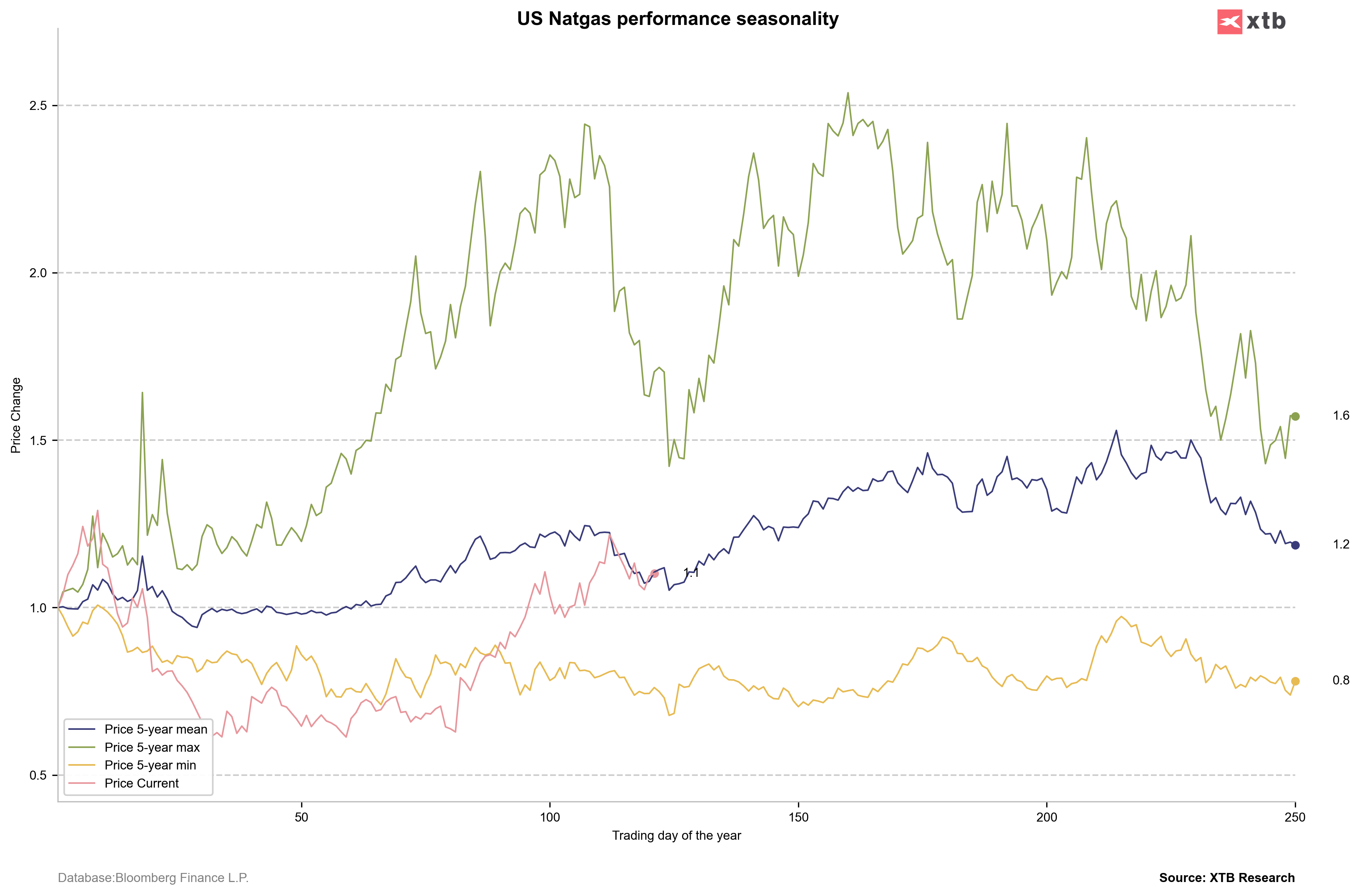
Seasonality, however, indicates that the local bottom is just a few days ahead, and in July there is a chance for a potential return to growth. Source: Bloomberg Finance LP, XTB
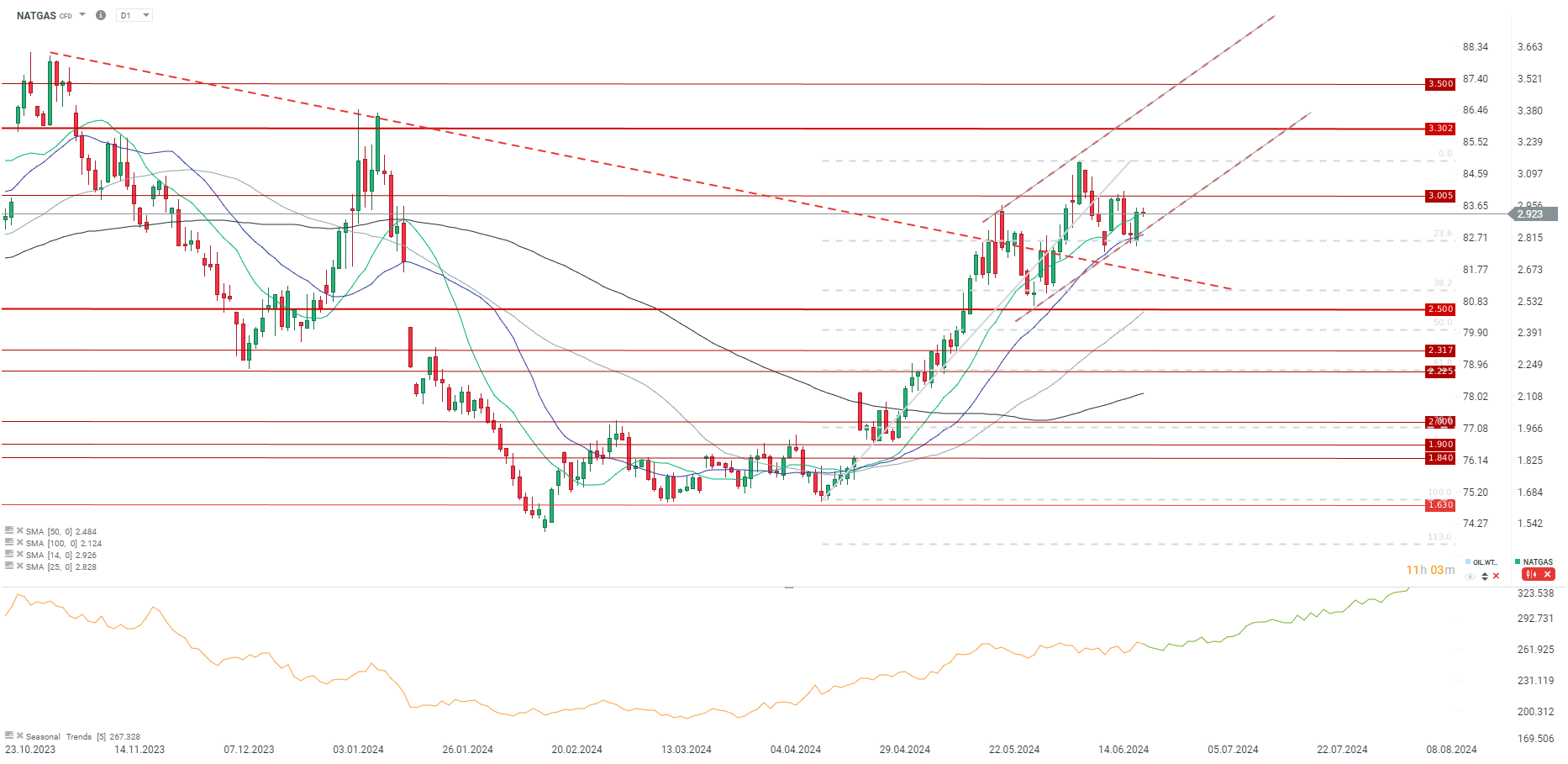
The price does not deviate significantly from the 14-period average, and an upward trend channel is maintained. Key support is around the level of 2.8 USD/MMBTU. Source: Bloomberg Finance LP, XTB
Coffee
- The rise in coffee prices is linked to continued weak export data from Vietnam, suggesting a low available supply of coffee, particularly Robusta. Coffee exports from Vietnam fell by 5.8% year-on-year from January to May
- Additionally, low rainfall in Brazil raises concerns about droughts, which could worsen the outlook for coffee harvests in the country. On the other hand, the current harvests are quite solid and are accelerated due to the weather conditions
- The latest USDA report on the coffee market shows an increase in expected production in key Arabica growing regions, with higher production anticipated in Brazil and Colombia. Coffee stocks at the end of the season are expected to be higher, especially in EU countries, estimated at 11.6 million bags
- Stocks in ICE warehouses have been steadily increasing since December last year, which may be related to changes in coffee certification. Current stocks are more than 50% higher than last year, but overall, stocks remain relatively low
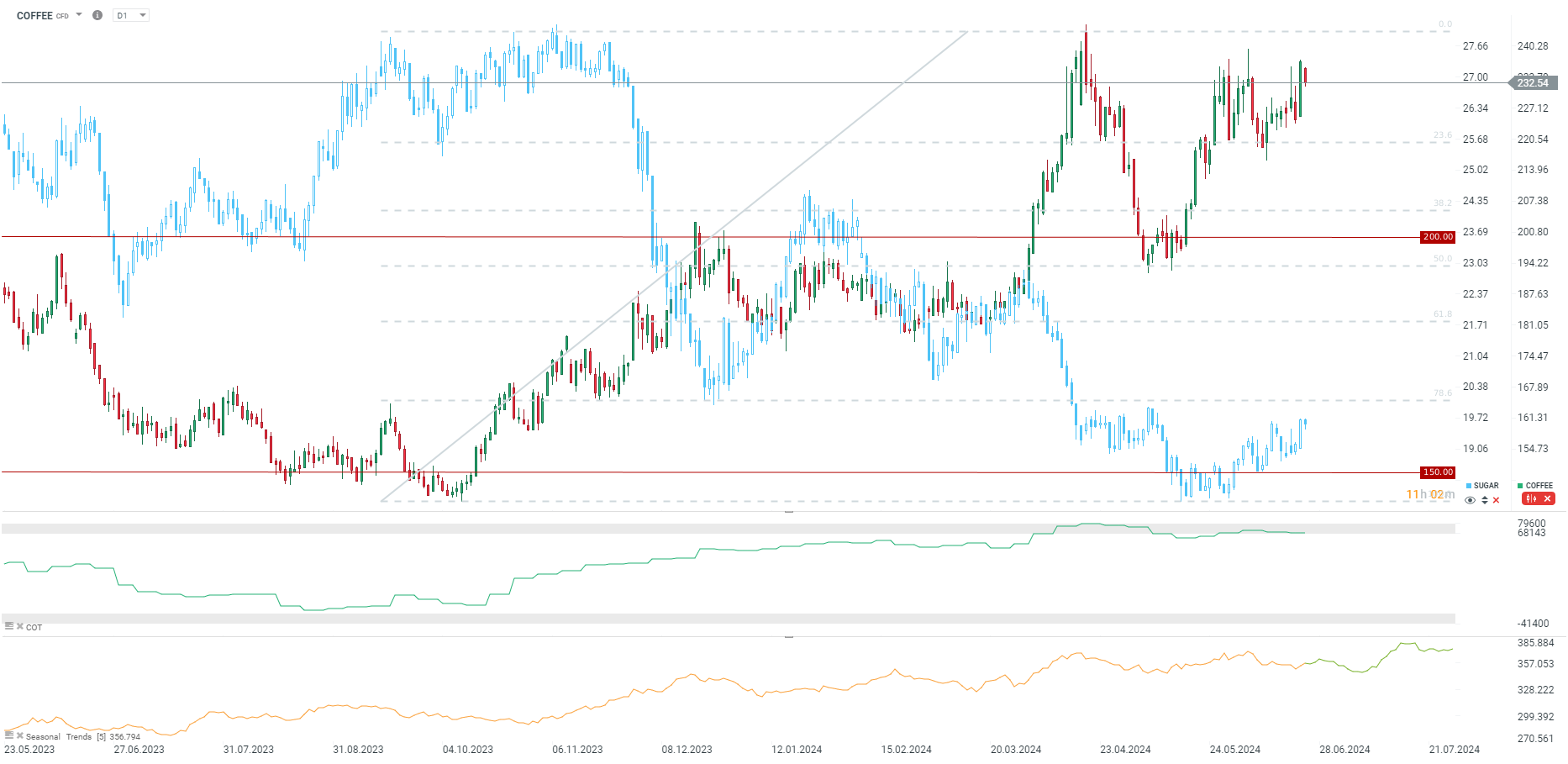
Coffee prices are returning to around 230-240 cents per pound. Interestingly, coffee prices are high despite a weak Brazilian real and very low sugar prices. It is worth noting that speculative positioning in coffee market remains high. Source: xStation5
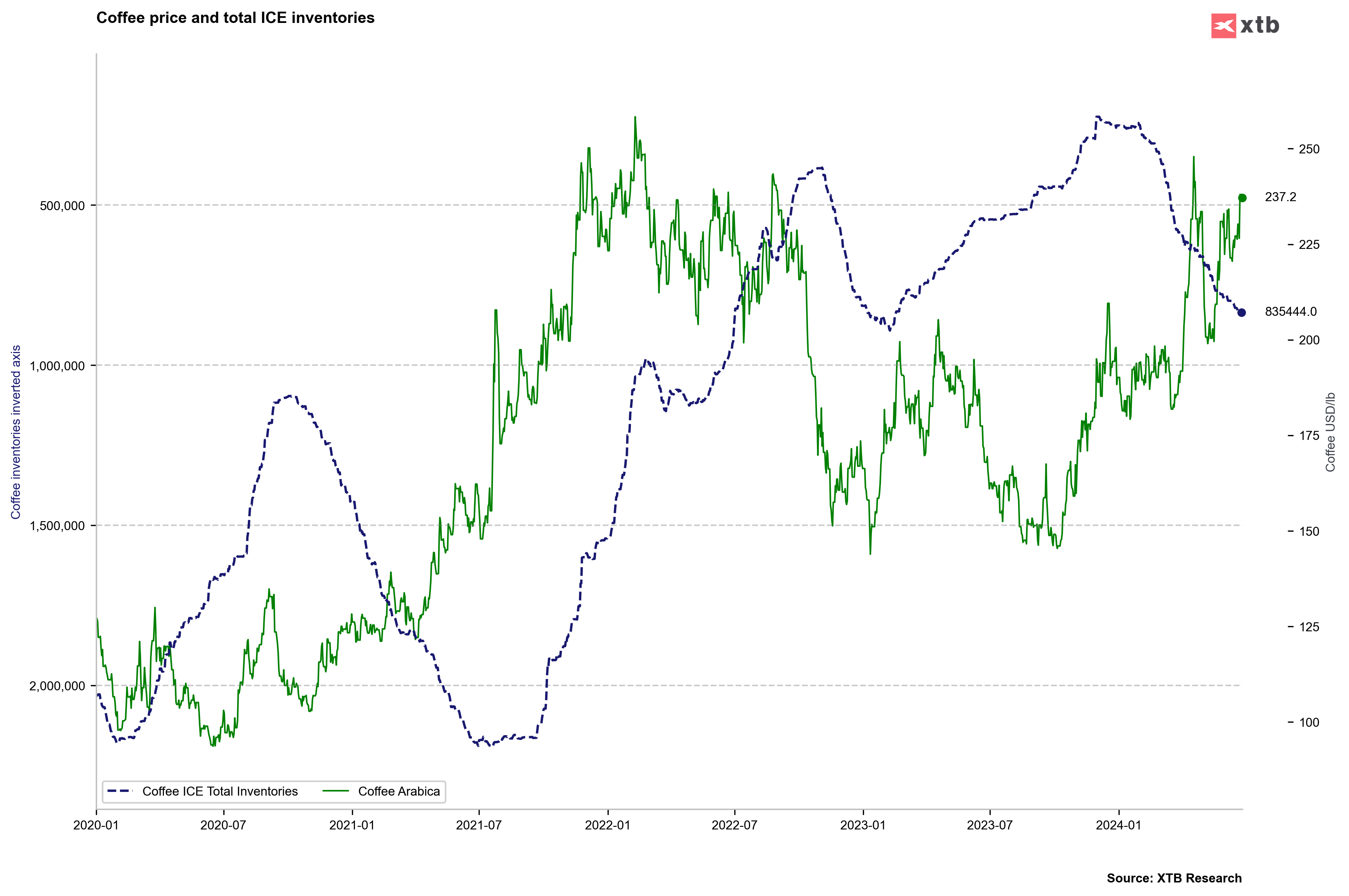
Coffee stocks are now close to the peak seen at the beginning of 2021. However, the rising stocks indicate that the supply of Arabica on the market is not an issue, and the price increases are mainly driven by availability problems with Robusta. Source: Bloomberg Finance LP, XTB
Cocoa
- The ICCO revised its end-of-year deficit estimate at the end of May, indicating it will be 439,000 tons, up from the previous estimate of 374,000 tons. The ICCO notes that production is expected to be slightly higher by 11,000 tons, reaching 4.461 million tons in the 2023/2024 season. Production is expected to increase in Nigeria, Guinea, Congo, the Dominican Republic, and Peru, but it is expected to decline significantly in Ghana
- In Ghana, there is a significant issue with cocoa tree diseases and the establishment of illegal mining operations on cocoa farms
- The ICCO has significantly revised its cocoa processing forecast upwards, with processing expected to reach 4.855 million tons. This is still lower than in previous seasons, but it indicates that demand destruction has not yet occurred
- Ivory Coast raised the minimum price paid to farmers to 2,460 USD per ton (which is several times lower than the market price) in April. However, this represented a 50% increase compared to the previous price in October. Deliveries to ports in Ivory Coast reached just under 1.5 million tons by the end of May, a 29% decrease compared to the previous season. This does not necessarily mean a 30% drop in yields, as domestic processing is also increasing
- Ivory Coast's cocoa and coffee regulator has stopped selling contracts for cocoa deliveries for the 2024/2025 season
- Deliveries in Ghana are down by 33.7% compared to the previous season
- Production in Ghana is expected to be 450,000 tons this season, down from the initial forecast of 800,000 tons last year. In the 2022/2023 season, production was 700,000 tons
- The next key processing data for Q2 will be available on July 11.
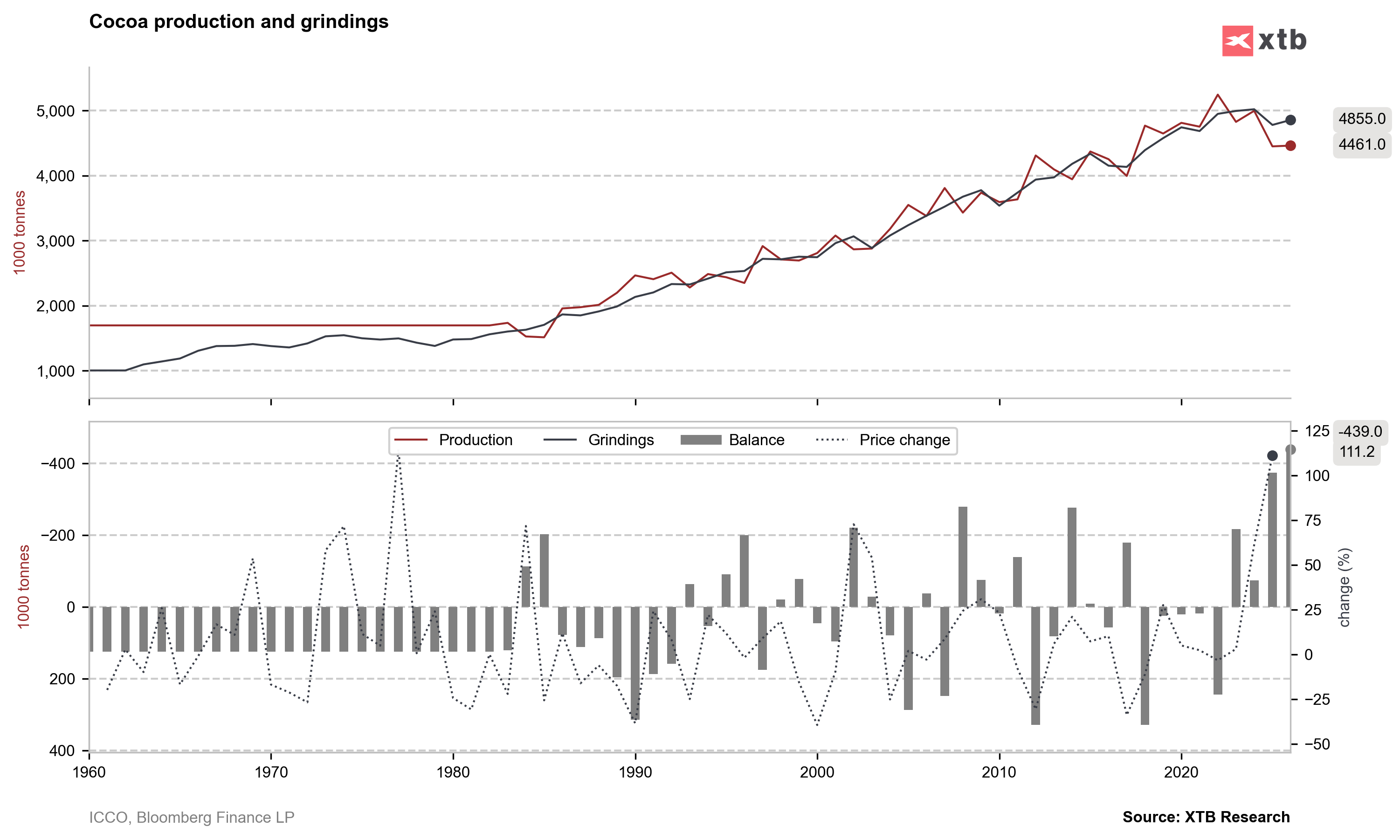
The cocoa market deficit for the 2023/2024 season is expected to be larger than initially anticipated. However, uncertainty regarding demand data for Q2 and still low liquidity is leading to a sell-off in the market. Source: Bloomberg Finance LP, XTB
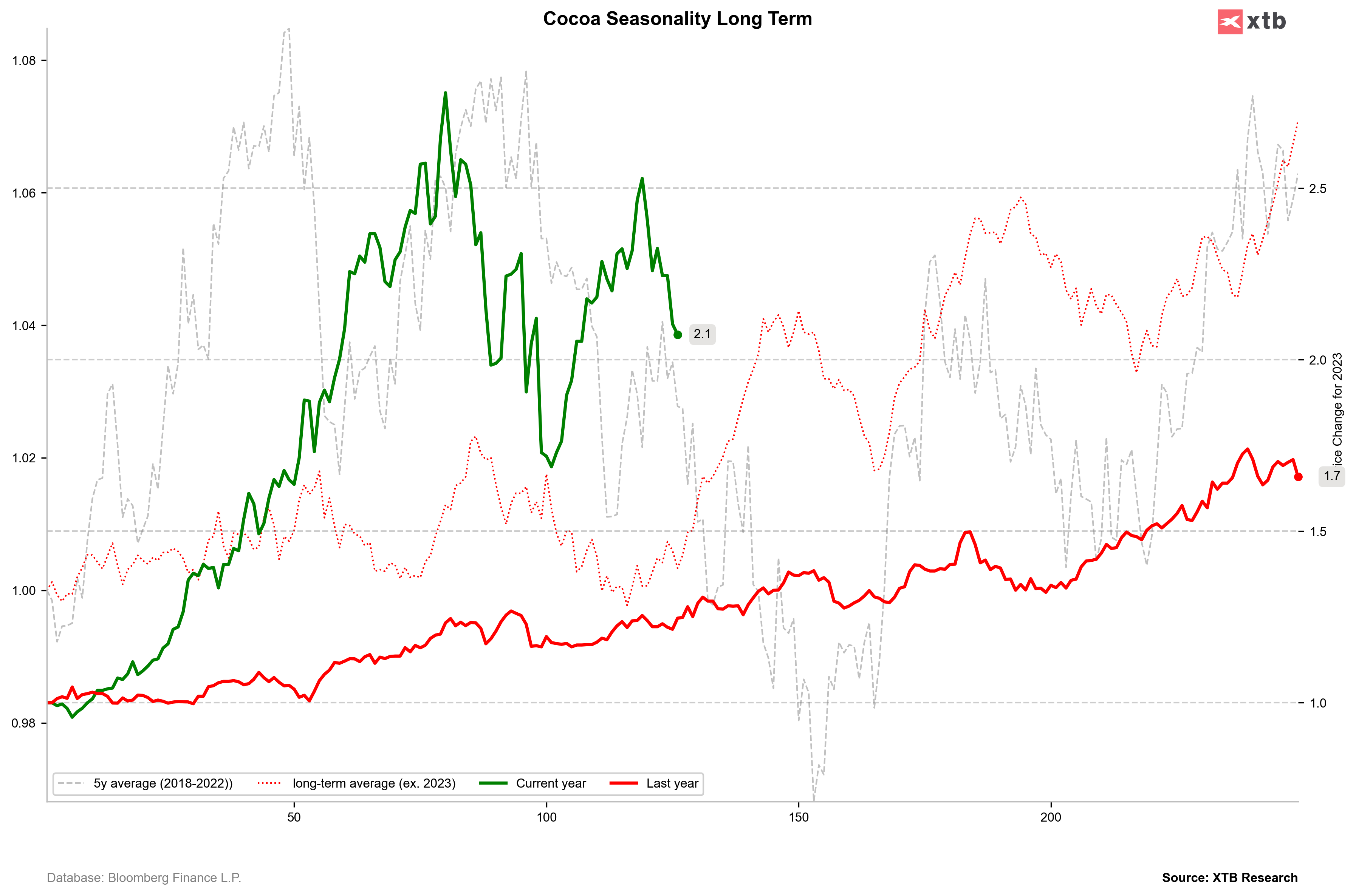
Short-term seasonality (excluding 2023) suggests that the declines in cocoa may continue. Conversely, long-term price behavior indicates that a potential bottom should already be behind us. Long-term seasonality and the year 2023 suggest that the end of July could be a local peak. The 5-year average indicates that early August is a local bottom for cocoa. Source: Bloomberg Finance LP, XTB
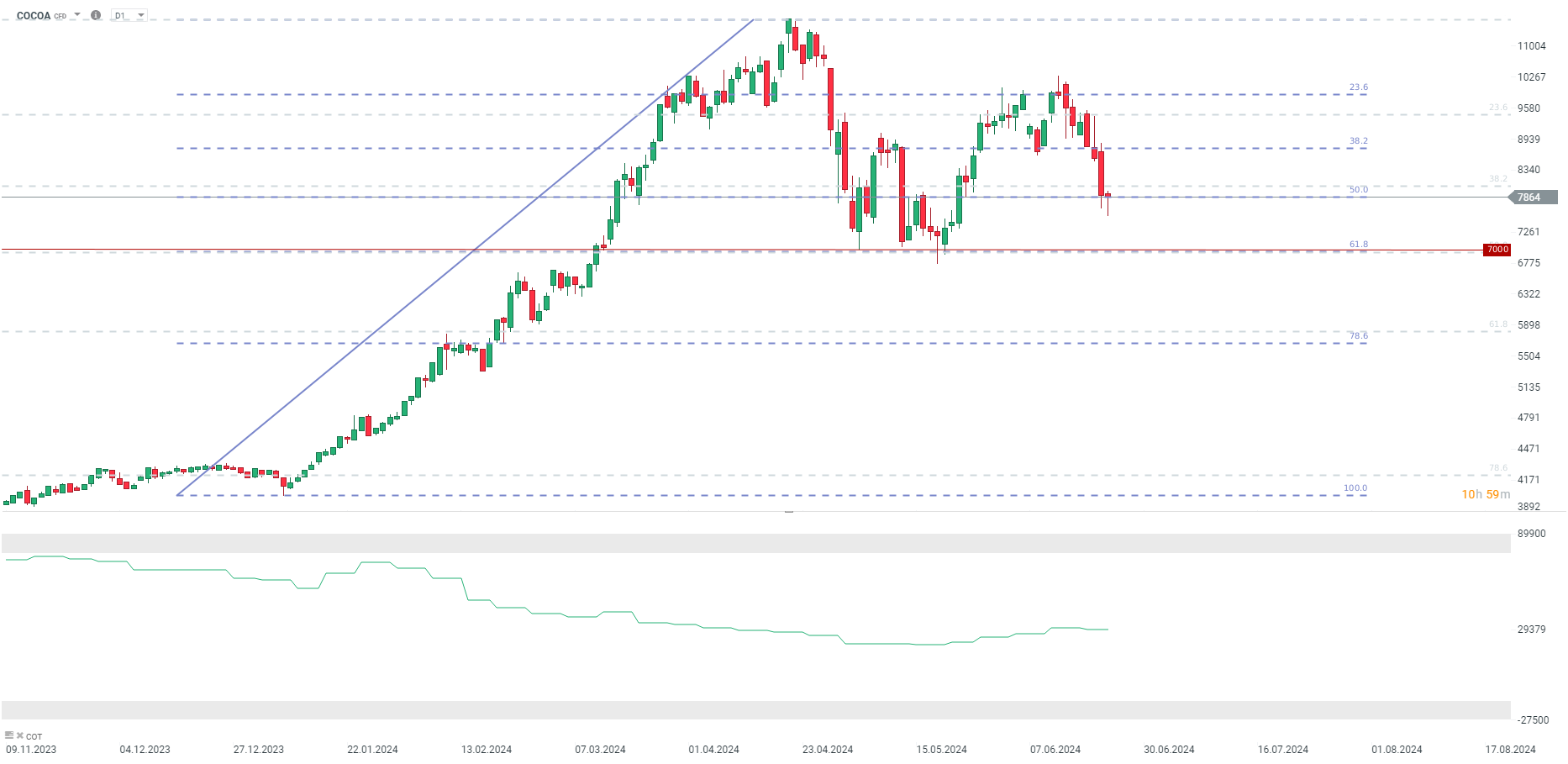
Cocoa prices have been dropping sharply since the beginning of this week, even though there is still a lot of time before the demand report is released. If we were to experience a 1:1 correction, looking at the movement from late April to early May, the current move could indicate prices as low as 6,100 USD per ton. Source: xStation5
🚨Oil slides 2%
Morning wrap (25.11.2025)
Daily summary: Tech leads Wall Street rally, dollar stable despite dovish Fed (21.11.2025)
Cocoa futures recover 1% from 21-month low 🍫
The content of this report has been created by XTB S.A., with its registered office in Warsaw, at Prosta 67, 00-838 Warsaw, Poland, (KRS number 0000217580) and supervised by Polish Supervision Authority ( No. DDM-M-4021-57-1/2005). This material is a marketing communication within the meaning of Art. 24 (3) of Directive 2014/65/EU of the European Parliament and of the Council of 15 May 2014 on markets in financial instruments and amending Directive 2002/92/EC and Directive 2011/61/EU (MiFID II). Marketing communication is not an investment recommendation or information recommending or suggesting an investment strategy within the meaning of Regulation (EU) No 596/2014 of the European Parliament and of the Council of 16 April 2014 on market abuse (market abuse regulation) and repealing Directive 2003/6/EC of the European Parliament and of the Council and Commission Directives 2003/124/EC, 2003/125/EC and 2004/72/EC and Commission Delegated Regulation (EU) 2016/958 of 9 March 2016 supplementing Regulation (EU) No 596/2014 of the European Parliament and of the Council with regard to regulatory technical standards for the technical arrangements for objective presentation of investment recommendations or other information recommending or suggesting an investment strategy and for disclosure of particular interests or indications of conflicts of interest or any other advice, including in the area of investment advisory, within the meaning of the Trading in Financial Instruments Act of 29 July 2005 (i.e. Journal of Laws 2019, item 875, as amended). The marketing communication is prepared with the highest diligence, objectivity, presents the facts known to the author on the date of preparation and is devoid of any evaluation elements. The marketing communication is prepared without considering the client’s needs, his individual financial situation and does not present any investment strategy in any way. The marketing communication does not constitute an offer of sale, offering, subscription, invitation to purchase, advertisement or promotion of any financial instruments. XTB S.A. is not liable for any client’s actions or omissions, in particular for the acquisition or disposal of financial instruments, undertaken on the basis of the information contained in this marketing communication. In the event that the marketing communication contains any information about any results regarding the financial instruments indicated therein, these do not constitute any guarantee or forecast regarding the future results.


